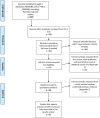The efficacy of manual therapy and exercise for different stages of non-specific low back pain: an update of systematic reviews
- PMID: 24976749
- PMCID: PMC4017797
- DOI: 10.1179/2042618613Y.0000000041
The efficacy of manual therapy and exercise for different stages of non-specific low back pain: an update of systematic reviews
Abstract
Objective: to review and update the evidence for different forms of manual therapy (MT) for patients with different stages of non-specific low back pain (LBP).
Data sources: MEDLINE, Cochrane-Register-of-Controlled-Trials, PEDro, EMBASE.
Method: A systematic review of MT with a literature search covering the period of January 2000 to April 2013 was conducted by two independent reviewers according to Cochrane and PRISMA guidelines. A total of 360 studies were evaluated using qualitative criteria. Two stages of LBP were categorized; combined acute-subacute and chronic. Further sub-classification was made according to MT intervention: MT1 (manipulation); MT2 (mobilization and soft-tissue-techniques); and MT3 (MT1 combined with MT2). In each sub-category, MT could be combined or not with exercise or usual medical care (UMC). Consequently, quantitative evaluation criteria were applied to 56 eligible randomized controlled trials (RCTs), and hence 23 low-risk of bias RCTs were identified for review. Only studies providing new updated information (11/23 RCTs) are presented here.
Results: Acute-subacute LBP: STRONG-evidence in favour of MT1 when compared to sham for pain, function and health improvements in the short-term (1-3 months). MODERATE-evidence to support MT1 and MT3 combined with UMC in comparison to UMC alone for pain, function and health improvements in the short-term. Chronic LBP: MODERATE to STRONG-evidence in favour of MT1 in comparison to sham for pain, function and overall-health in the short-term. MODERATE-evidence in favour of MT3 combined with exercise or UMC in comparison to exercise and back-school was established for pain, function and quality-of-life in the short and long-term. LIMITED-evidence in favour of MT2 combined with exercise and UMC in comparison to UMC alone for pain and function from short to long-term. LIMITED-evidence of no effect for MT1 with extension-exercise compared to extension-exercise alone for pain in the short to long-term.
Conclusion: This systematic review updates the evidence for MT with exercise or UMC for different stages of LBP and provides recommendations for future studies.
Keywords: Efficacy; Manual therapy; Non-specific low back pain; Randomized controlled trials; Spinal manipulation.
Similar articles
-
Therapeutic ultrasound for chronic low back pain.Cochrane Database Syst Rev. 2020 Jul 5;7(7):CD009169. doi: 10.1002/14651858.CD009169.pub3. Cochrane Database Syst Rev. 2020. PMID: 32623724 Free PMC article.
-
Is immediate imaging important in managing low back pain?J Athl Train. 2011 Jan-Feb;46(1):99-102. doi: 10.4085/1062-6050-46.1.99. J Athl Train. 2011. PMID: 21214357 Free PMC article.
-
Non-steroidal anti-inflammatory drugs for acute low back pain.Cochrane Database Syst Rev. 2020 Apr 16;4(4):CD013581. doi: 10.1002/14651858.CD013581. Cochrane Database Syst Rev. 2020. PMID: 32297973 Free PMC article.
-
Folic acid supplementation and malaria susceptibility and severity among people taking antifolate antimalarial drugs in endemic areas.Cochrane Database Syst Rev. 2022 Feb 1;2(2022):CD014217. doi: 10.1002/14651858.CD014217. Cochrane Database Syst Rev. 2022. PMID: 36321557 Free PMC article.
-
Noninvasive Nonpharmacological Treatment for Chronic Pain: A Systematic Review [Internet].Rockville (MD): Agency for Healthcare Research and Quality (US); 2018 Jun. Report No.: 18-EHC013-EF. Rockville (MD): Agency for Healthcare Research and Quality (US); 2018 Jun. Report No.: 18-EHC013-EF. PMID: 30179389 Free Books & Documents. Review.
Cited by
-
An Updated Overview of Low Back Pain Management.Asian Spine J. 2022 Dec;16(6):968-982. doi: 10.31616/asj.2021.0371. Epub 2021 Dec 30. Asian Spine J. 2022. PMID: 34963043 Free PMC article.
-
Effects of the Addition of Hands-on Procedures to McKenzie Exercises on Pain, Functional Disability and Back Mobility in Patients with Low Back Pain: A Randomised Clinical Trial.Malays J Med Sci. 2023 Jun;30(3):122-134. doi: 10.21315/mjms2023.30.3.11. Epub 2023 Jun 27. Malays J Med Sci. 2023. PMID: 37425389 Free PMC article.
-
The effect of spinal manipulation on brain neurometabolites in chronic nonspecific low back pain patients: a randomized clinical trial.Ir J Med Sci. 2020 May;189(2):543-550. doi: 10.1007/s11845-019-02140-2. Epub 2019 Nov 26. Ir J Med Sci. 2020. PMID: 31773541 Clinical Trial.
-
Influence of Stabilization Techniques Used in the Treatment of Low Back Pain on the Level of Kinesiophobia.Int J Environ Res Public Health. 2021 Jun 13;18(12):6393. doi: 10.3390/ijerph18126393. Int J Environ Res Public Health. 2021. PMID: 34199155 Free PMC article.
-
Scoping review of systematic reviews of complementary medicine for musculoskeletal and mental health conditions.BMJ Open. 2018 Oct 15;8(10):e020222. doi: 10.1136/bmjopen-2017-020222. BMJ Open. 2018. PMID: 30327397 Free PMC article.
References
-
- Waddell G. The back pain revolution. 2nd ed. Edinburgh: Churchill Livingstone; 2005.
-
- Balague F, Mannion AF, Pellise F, Cedraschi C. Non-specific low back pain. Lancet. 2012;379:482–91. - PubMed
-
- Maniadakis N, Gray A. The economic burden of back pain in the UK. Pain. 2000;84:95–103. - PubMed
-
- Dagenais S, Caro J, Haldeman S. A systematic review of low back pain cost of illness studies in the United States and internationally. Spine J. 2008;8:8–20. - PubMed
LinkOut - more resources
Full Text Sources
Other Literature Sources
Medical
Miscellaneous

